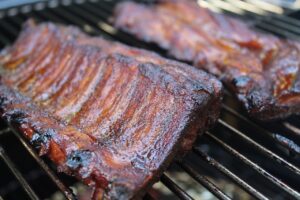If you love cooking, you’re probably familiar with deep frying and pan frying. Both methods involve cooking food in hot oil, but there are some key differences between the two.
In this article, we’ll take a closer look at deep frying vs pan frying, and explore the pros and cons of each method.
Deep Frying
Deep frying involves fully submerging food in hot oil. This method is great for achieving a crispy exterior and a moist interior. Some popular deep-fried foods include french fries, chicken wings, and donuts.
Pros:
- Creates a crispy exterior
- Moist interior
- Quick cooking time
- Can cook large quantities of food at once
Cons:
- Uses a lot of oil
- Can be dangerous if not done safely
- Can be unhealthy due to the amount of oil used
Equipment needed for deep frying:
- Deep fryer or large pot
- Thermometer
- Tongs or slotted spoon
- Paper towels
Tips for deep frying safely and effectively:
- Use a deep fryer or a large pot with high sides to prevent oil splatters.
- Use a thermometer to ensure the oil is at the correct temperature.
- Don’t overcrowd the pot or fryer, as this can cause the temperature to drop and result in soggy food.
- Use tongs or a slotted spoon to remove the food from the oil.
- Place the cooked food on paper towels to absorb excess oil.
Pan Frying
Pan frying involves cooking food in a shallow layer of oil in a frying pan. This method is great for cooking small pieces of food, such as chicken breasts or fish fillets.
Pros:
- Uses less oil than deep frying
- Can be healthier than deep frying
- Easy to do at home
- Great for cooking small pieces of food
Cons:
- Can be messy
- Can result in uneven cooking
- Can take longer than deep frying
Equipment needed for pan frying:
- Frying pan
- Spatula
- Paper towels
Tips for pan frying safely and effectively:
- Use a frying pan with a non-stick coating to prevent the food from sticking.
- Use a small amount of oil to prevent the food from sticking and to create a crispy exterior.
- Don’t overcrowd the pan, as this can cause the food to steam instead of fry.
- Flip the food halfway through cooking to ensure even cooking on both sides.
- Place the cooked food on paper towels to absorb excess oil.
Comparison
When it comes to deep frying vs pan frying, there are a few key differences to consider. Deep frying creates a crispy exterior and a moist interior, but uses a lot of oil and can be unhealthy. Pan frying uses less oil and can be healthier, but can result in uneven cooking and can be messy.
When to use deep frying vs pan frying:
- Use deep frying for foods that need a crispy exterior and a moist interior, such as french fries or chicken wings.
- Use pan frying for small pieces of food that need to be cooked quickly, such as chicken breasts or fish fillets.
Health considerations:
- Deep frying uses a lot of oil and can be unhealthy if done frequently.
- Pan frying uses less oil and can be a healthier option.
Taste and texture differences:
- Deep frying creates a crispy exterior and a moist interior.
- Pan frying creates a crispy exterior and a drier interior.
Conclusion
In conclusion, deep frying vs pan frying both have their pros and cons. Deep frying is great for achieving a crispy exterior and a moist interior, but uses a lot of oil and can be unhealthy. Pan frying uses less oil and can be a healthier option, but can result in uneven cooking and can be messy.
Ultimately, the choice between deep frying vs pan frying will depend on the food you’re cooking and your personal preferences. So, why not try both methods and experiment with different foods?
